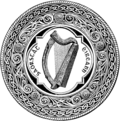President of the Executive Council of the Irish Free State
| President of the Executive Council of the Irish Free State | |
|---|---|
 Great Seal of the Irish Free State | |
| Residence | No official residence |
| Appointer | Governor-General, upon the nomination of Dáil Éireann |
| Precursor | Chairman of the Provisional Government of the Irish Free State |
| Formation | 6 December 1922 |
| First holder | W. T. Cosgrave |
| Final holder | Éamon de Valera |
| Abolished | 29 December 1937 |
| Succession | Taoiseach |
The President of the Executive Council of the Irish Free State (Irish: Uachtarán ar Ard-Chomhairle Shaorstát Éireann) was the head of government or prime minister of the Irish Free State which existed from 1922 to 1937. The president was appointed by the Governor-General, upon the nomination of Dáil Éireann (the lower house of parliament) and had to enjoy the confidence of the Dáil to remain in office. The office was succeeded by that of Taoiseach, though subsequent Taoisigh are numbered from the first President of the Executive.
Contents
1 Appointment
2 Powers
3 History
4 Officeholders
5 See also
6 Footnotes
7 References
Appointment
The President of the Executive Council was appointed by the governor-general, though the governor-general was bound by constitutional convention to appoint the individual nominated by the Dáil. For the same reason, although notionally the viceroy exercised the executive authority of the state, in practice he did so only at the direction of the President of the Executive Council, making the latter the Free State's political leader. Once he had appointed the president, the governor-general appointed the remaining members of the Executive Council on the president's nomination. The president had the freedom to choose, from among members of the Dáil, any vice-president he wished, but the remainder of the cabinet had to be approved by a vote of consent in the Dáil before they could assume office. If he ceased to "retain the support of a majority in Dáil Éireann," the president, along with his cabinet, was obliged to resign, but could continue to serve as acting president until the appointment of a successor.
The method of appointment of the President of the Executive Council was through a commission of the monarch or governor-general, either the leader of the party with a majority of seats in the lower house of parliament or, if no party commanded an absolute majority, whichever leader he believed would be best able to avoid a vote of no confidence.
Powers
The office of the President of the Executive Council was less powerful than either its modern equivalent, the office of Taoiseach, or the offices of most modern prime ministers in nations that follow the parliamentary system of government. In particular, the powers of the President were subject to two important limitations:
- He could not dismiss a member of the Executive Council individually. Rather, the Executive Council had to be disbanded and reformed as a whole in order to replace a single minister.
- He could not request a dissolution of parliament on his own initiative. This could only be done by the Executive Council acting collectively.
The result of these restrictions was, according to Brian Farrell, that the President of the Executive Council was closer to being the Executive Council's chairman or presiding officer, than its dominant leader. Nonetheless a strong president could exercise authority beyond the limits laid down in the 1922 constitution.[notes 1] The president's weak position arose from the fact that the status of his office was modelled on that of the Prime Minister of the United Kingdom before 1918. Until 1918, the British prime minister's powers had been theoretically quite limited and, as a member of the cabinet, the office-holder was regarded strictly as primus inter pares. Under Prime Minister David Lloyd George, however, from 1918 onwards, the powers of the office increased, as Lloyd George unilaterally claimed for himself powers that had previously belonged to the Cabinet collectively, including, most dramatically, the right to seek a parliamentary dissolution.
History
The office of President of the Executive Council came into being with the establishment of the Irish Free State in 1922, replacing the previous offices of President of the Irish Republic and Chairman of the Provisional Government. Only two individuals held the office of President of the Executive Council during its existence: W. T. Cosgrave, until 1932, and Éamon de Valera thereafter. In 1936 and 1937 the office of Governor-General was abolished, with most[citation needed] of his powers being transferred to the Executive Council. At the same time, the President of the Executive Council ceased to be formally appointed by the Governor-General, thenceforth simply being elected by the Dáil.
The Irish Free State was reconstituted as 'Ireland' on 29 December 1937, when the present-day Constitution of Ireland came into effect. The new Constitution abolished the office of President of the Executive Council, replacing it with that of Taoiseach (prime minister - literally meaning "Chieftain" or "Leader"[1]). The Taoiseach occupies a more powerful position than the President of the Executive Council did and has authority both to dismiss ministers individually and to request a dissolution of parliament on his own initiative.
Officeholders
| No. | Name | Picture | Term of office | Elected | Party | ||
|---|---|---|---|---|---|---|---|
| 1. | W. T. Cosgrave |  | 6 December 1922 | 9 March 1932 | 5 terms | Cumann na nGaedheal | |
| 2. | Éamon de Valera |  | 9 March 1932 | 29 December 1937 | 3 terms | Fianna Fáil | |
Position replaced by Taoiseach of Ireland in December 1937 | |||||||
See also
- Irish heads of government since 1919
Footnotes
^ See Brian Farrell, Chairman or chief? : the role of Taoiseach in Irish government, 1971.
References
^ Taoiseach Website (FAQ)